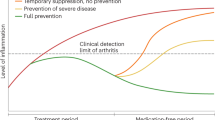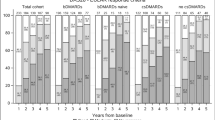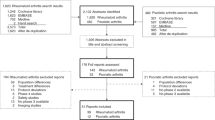Abstract
Treat-to-target has been established as a guiding principle for the treatment of rheumatoid arthritis (RA) and encompasses several distinct elements: choosing a target and a method for measuring it; assessing the target at a pre-specified time point; a commitment to change the therapy if the target is not achieved; and shared decision-making. A treat-to-target approach yields superior outcomes to standard care in RA, and the ACR, EULAR and other professional organizations have endorsed treat-to-target as a fundamental therapeutic strategy for RA. Nevertheless, data on the degree to which treat-to-target is employed in the clinic are scarce; it seems that although some elements of treat-to-target are widely used, full implementation remains uncommon. Outstanding knowledge gaps to be addressed include how to select the right target for each patient, how often to assess whether the target has been achieved and the selection of each subsequent therapy in an evidence-based manner.
This is a preview of subscription content, access via your institution
Access options
Access Nature and 54 other Nature Portfolio journals
Get Nature+, our best-value online-access subscription
$29.99 / 30 days
cancel any time
Subscribe to this journal
Receive 12 print issues and online access
$209.00 per year
only $17.42 per issue
Buy this article
- Purchase on Springer Link
- Instant access to full article PDF
Prices may be subject to local taxes which are calculated during checkout


Similar content being viewed by others
References
Poulter, N. R., Prabhakaran, D. & Caulfield, M. Hypertension. Lancet 386, 801–812 (2015).
Verdecchia, P. et al. Usual versus tight control of systolic blood pressure in non-diabetic patients with hypertension (Cardio-Sis): an open-label randomised trial. Lancet 374, 525–533 (2009).
Nathan, D. M. et al. Intensive diabetes treatment and cardiovascular disease in patients with type 1 diabetes. N. Engl. J. Med. 353, 2643–2653 (2005).
Soran, H., Dent, R. & Durrington, P. Evidence-based goals in LDL-C reduction. Clin. Res. Cardiol. 106, 237–248 (2017).
Smolen, J. S. et al. Treating rheumatoid arthritis to target: recommendations of an international task force. Ann. Rheum. Dis. 69, 631–637 (2010).
Smolen, J. S. et al. Treating rheumatoid arthritis to target: 2014 update of the recommendations of an international task force. Ann. Rheum. Dis. 75, 3–15 (2016).
Winthrop, K. L. et al. The unmet need in rheumatology: reports from the targeted therapies meeting 2017. Clin. Immunol. 186, 87–93 (2018).
Smolen, J. S. et al. EULAR recommendations for the management of rheumatoid arthritis with synthetic and biological disease-modifying antirheumatic drugs: 2016 update. Ann. Rheum. Dis. 76, 960–977 (2017).
Singh, J. A. et al. 2015 American College of Rheumatology guideline for the treatment of rheumatoid arthritis. Arthritis Rheumatol. 68, 1–26 (2016).
Prevoo, M. L. et al. Modified disease activity scores that include twenty-eight-joint counts. Development and validation in a prospective longitudinal study of patients with rheumatoid arthritis. Arthritis Rheum. 38, 44–48 (1995).
Aletaha, D. & Smolen, J. The Simplified Disease Activity Index (SDAI) and the Clinical Disease Activity Index (CDAI): a review of their usefulness and validity in rheumatoid arthritis. Clin. Exp. Rheumatol. 23 (Suppl. 39), S100–S108 (2005).
Smolen, J. S. & Aletaha, D. Scores for all seasons: SDAI and CDAI. Clin. Exp. Rheumatol. 32 (Suppl. 85), S75–S79 (2014).
Anderson, J. K., Zimmerman, L., Caplan, L. & Michaud, K. Measures of rheumatoid arthritis disease activity: Patient (PtGA) and Provider (PrGA) Global Assessment of Disease Activity, Disease Activity Score (DAS) and Disease Activity Score with 28-Joint Counts (DAS28), Simplified Disease Activity Index (SDAI), Clinical Disease Activity Index (CDAI), Patient Activity Score (PAS) and Patient Activity Score-II (PASII), Routine Assessment of Patient Index Data (RAPID), Rheumatoid Arthritis Disease Activity Index (RADAI) and Rheumatoid Arthritis Disease Activity Index-5 (RADAI-5), Chronic Arthritis Systemic Index (CASI), Patient-Based Disease Activity Score With ESR (PDAS1) and Patient-Based Disease Activity Score without ESR (PDAS2), and Mean Overall Index for Rheumatoid Arthritis (MOI-RA). Arthritis Care Res. 63 (Suppl. 11), S14–S36 (2011).
Farheen, K. & Agarwal, S. K. Assessment of disease activity and treatment outcomes in rheumatoid arthritis. J. Manag. Care Pharm. 17 (Suppl. B), S09–S13 (2011).
Gaujoux-Viala, C. et al. Evaluating disease activity in rheumatoid arthritis: which composite index is best? A systematic literature analysis of studies comparing the psychometric properties of the DAS, DAS28, SDAI and CDAI. Joint Bone Spine 79, 149–155 (2012).
Bentley, M. J. & Reed, G. W. Simplified composite disease activity measures in rheumatoid arthritis: should they be used in standard care? Clin. Exp. Rheumatol. 26, 358–366 (2008).
Makinen, H., Hannonen, P. & Sokka, T. Definitions of remission for rheumatoid arthritis and review of selected clinical cohorts and randomised clinical trials for the rate of remission. Clin. Exp. Rheumatol. 24 (Suppl. 43), S22–S28 (2006).
Schoels, M., Alasti, F., Smolen, J. S. & Aletaha, D. Evaluation of newly proposed remission cut-points for disease activity score in 28 joints (DAS28) in rheumatoid arthritis patients upon IL-6 pathway inhibition. Arthritis Res. Ther. 19, 155 (2017).
Hirsh, J. et al. Limited health literacy predicts patient confusion about patient global assessments of disease activity and rheumatoid arthritis model disease states. Arthritis Care Res. https://doi.org/10.1002/acr.23692 (2018).
Canhao, H. et al. Common evaluations of disease activity in rheumatoid arthritis reach discordant classifications across different populations. Front. Med. (Lausanne) 5, 40 (2018).
Ferreira, R. J. O. et al. Drivers of patient global assessment in patients with rheumatoid arthritis who are close to remission: an analysis of 1588 patients. Rheumatology 56, 1573–1578 (2017).
van Nies, J. A. et al. What is the evidence for the presence of a therapeutic window of opportunity in rheumatoid arthritis? A systematic literature review. Ann. Rheum. Dis. 73, 861–870 (2014).
Mottonen, T. et al. Comparison of combination therapy with single-drug therapy in early rheumatoid arthritis: a randomised trial. FIN-RACo trial group. Lancet 353, 1568–1573 (1999).
Pinals, R. S., Masi, A. T. & Larsen, R. A. Preliminary criteria for clinical remission in rheumatoid arthritis. Arthritis Rheum. 24, 1308–1315 (1981).
Grigor, C. et al. Effect of a treatment strategy of tight control for rheumatoid arthritis (the TICORA study): a single-blind randomised controlled trial. Lancet 364, 263–269 (2004).
Verstappen, S. M. et al. Intensive treatment with methotrexate in early rheumatoid arthritis: aiming for remission. Computer Assisted Management in Early Rheumatoid Arthritis (CAMERA, an open-label strategy trial). Ann. Rheum. Dis. 66, 1443–1449 (2007).
van Vollenhoven, R. F. et al. Addition of infliximab compared with addition of sulfasalazine and hydroxychloroquine to methotrexate in patients with early rheumatoid arthritis (SWEFOT trial): 1-year results of a randomised trial. Lancet 374, 459–466 (2009).
Goekoop-Ruiterman, Y. P. et al. Comparison of treatment strategies in early rheumatoid arthritis: a randomized trial. Ann. Intern. Med. 146, 406–415 (2007).
O’Dell, J. R. et al. Therapies for active rheumatoid arthritis after methotrexate failure. N. Engl. J. Med. 369, 307–318 (2013).
Haavardsholm, E. A. et al. Ultrasound in management of rheumatoid arthritis: ARCTIC randomised controlled strategy trial. BMJ 354, i4205 (2016).
Dale, J. et al. Targeting ultrasound remission in early rheumatoid arthritis: the results of the TaSER study, a randomised clinical trial. Ann. Rheum. Dis. 75, 1043–1050 (2016).
Møller-Bisgaard, S. et al. The value of adding MRI to a clinical treat-to-target strategy in rheumatoid arthritis patients in clinical remission: clinical and radiographic outcomes from the IMAGINE-RA randomised controlled trial [abstract]. Ann. Rheum. Dis. 77 (Suppl. 2), A58 (2018).
de Wit, M. P., Smolen, J. S., Gossec, L. & van der Heijde, D. M. Treating rheumatoid arthritis to target: the patient version of the international recommendations. Ann. Rheum. Dis. 70, 891–895 (2011).
Smolen, J. S. et al. EULAR recommendations for the management of rheumatoid arthritis with synthetic and biological disease-modifying antirheumatic drugs: 2013 update. Ann. Rheum. Dis. 73, 492–509 (2014).
Harrold, L. R. et al. Prescribing practices in a US cohort of rheumatoid arthritis patients before and after publication of the American College of Rheumatology treatment recommendations. Arthritis Rheum. 64, 630–638 (2012).
Gvozdenovic, E. et al. When rheumatologists report that they agree with a guideline, does this mean that they practise the guideline in clinical practice? Results of the International Recommendation Implementation Study (IRIS). RMD Open 2, e000221 (2016).
Yu, Z. et al. Implementation of treat-to-target for rheumatoid arthritis in the US: analysis of baseline data from a randomized controlled trial. Arthritis Care Res. 70, 801–806 (2018).
Solomon, D. H. et al. Implementation of treat-to-target in rheumatoid arthritis through a learning collaborative: results of a randomized controlled trial. Arthritis Rheumatol. 69, 1374–1380 (2017).
Felson, D. T. et al. American College of Rheumatology/European League against Rheumatism provisional definition of remission in rheumatoid arthritis for clinical trials. Ann. Rheum. Dis. 70, 404–413 (2011).
Hetland, M. L. et al. Aggressive combination therapy with intra-articular glucocorticoid injections and conventional disease-modifying anti-rheumatic drugs in early rheumatoid arthritis: second-year clinical and radiographic results from the CIMESTRA study. Ann. Rheum. Dis. 67, 815–822 (2008).
Horslev-Petersen, K. et al. Adalimumab added to a treat-to-target strategy with methotrexate and intra-articular triamcinolone in early rheumatoid arthritis increased remission rates, function and quality of life. The OPERA Study: an investigator-initiated, randomised, double-blind, parallel-group, placebo-controlled trial. Ann. Rheum. Dis. 73, 654–661 (2014).
Glinatsi, D. et al. Head-to-head comparison of aggressive conventional therapy and three biological treatments and comparison of two de-escalation strategies in patients who respond to treatment: study protocol for a multicenter, randomized, open-label, blinded-assessor, phase 4 study. Trials 18, 161 (2017).
Taylor, P. C. et al. Baricitinib versus placebo or adalimumab in rheumatoid arthritis. N. Engl. J. Med. 376, 652–662 (2017).
van Vollenhoven, R. F. et al. Tofacitinib or adalimumab versus placebo in rheumatoid arthritis. N. Engl. J. Med. 367, 508–519 (2012).
Fleischmann, R. et al. Efficacy and safety of tofacitinib monotherapy, tofacitinib with methotrexate, and adalimumab with methotrexate in patients with rheumatoid arthritis (ORAL Strategy): a phase 3b/4, double-blind, head-to-head, randomised controlled trial. Lancet 390, 457–468 (2017).
Hambardzumyan, K. et al. A multi-biomarker disease activity score and the choice of second-line therapy in early rheumatoid arthritis after methotrexate failure. Arthritis Rheumatol. 69, 953–963 (2017).
Porter, D., Dale, J. & Sattar, N. How low to aim in rheumatoid arthritis? Learning from other disciplines. Ann. Rheum. Dis. 73, 480–482 (2014).
Author information
Authors and Affiliations
Corresponding author
Ethics declarations
Competing interests
R.v.V. declares that he has received research support and grants from AbbVie, Bristol Myers Squibb, GlaxoSmithKline, Pfizer and UCB and consultancy fees or honoraria from AbbVie, AstraZeneca, Biogen, Biotest, Bristol Myers Squibb, Celgene, Gilead, GlaxoSmithKline, Janssen, Lilly, Novartis, Pfizer and UCB.
Additional information
Publisher’s note
Springer Nature remains neutral with regard to jurisdictional claims in published maps and institutional affiliations.
Reviewer information
Nature Reviews Rheumatology thanks S. Proudman, D. Porter and the other anonymous reviewer(s), for their contribution to the peer review of this work.
Rights and permissions
About this article
Cite this article
van Vollenhoven, R. Treat-to-target in rheumatoid arthritis — are we there yet?. Nat Rev Rheumatol 15, 180–186 (2019). https://doi.org/10.1038/s41584-019-0170-5
Published:
Issue Date:
DOI: https://doi.org/10.1038/s41584-019-0170-5
This article is cited by
-
Treat-to-Target in Atopic Dermatitis
American Journal of Clinical Dermatology (2024)
-
Neutrophilic Activity Biomarkers (Plasma Neutrophil Extracellular Traps and Calprotectin) in Established Patients with Rheumatoid Arthritis Receiving Biological or JAK Inhibitors: A Clinical and Ultrasonographic Study
Rheumatology and Therapy (2024)
-
Physical function and severe side effects matter most to patients with RA (< 5 years): a discrete choice experiment assessing preferences for personalized RA treatment
BMC Rheumatology (2023)
-
Nursing interventions for patients with rheumatic and musculoskeletal diseases on biological therapies: a systematic literature review
Clinical Rheumatology (2023)
-
Rheumatoid arthritis: advances in treatment strategies
Molecular and Cellular Biochemistry (2023)



